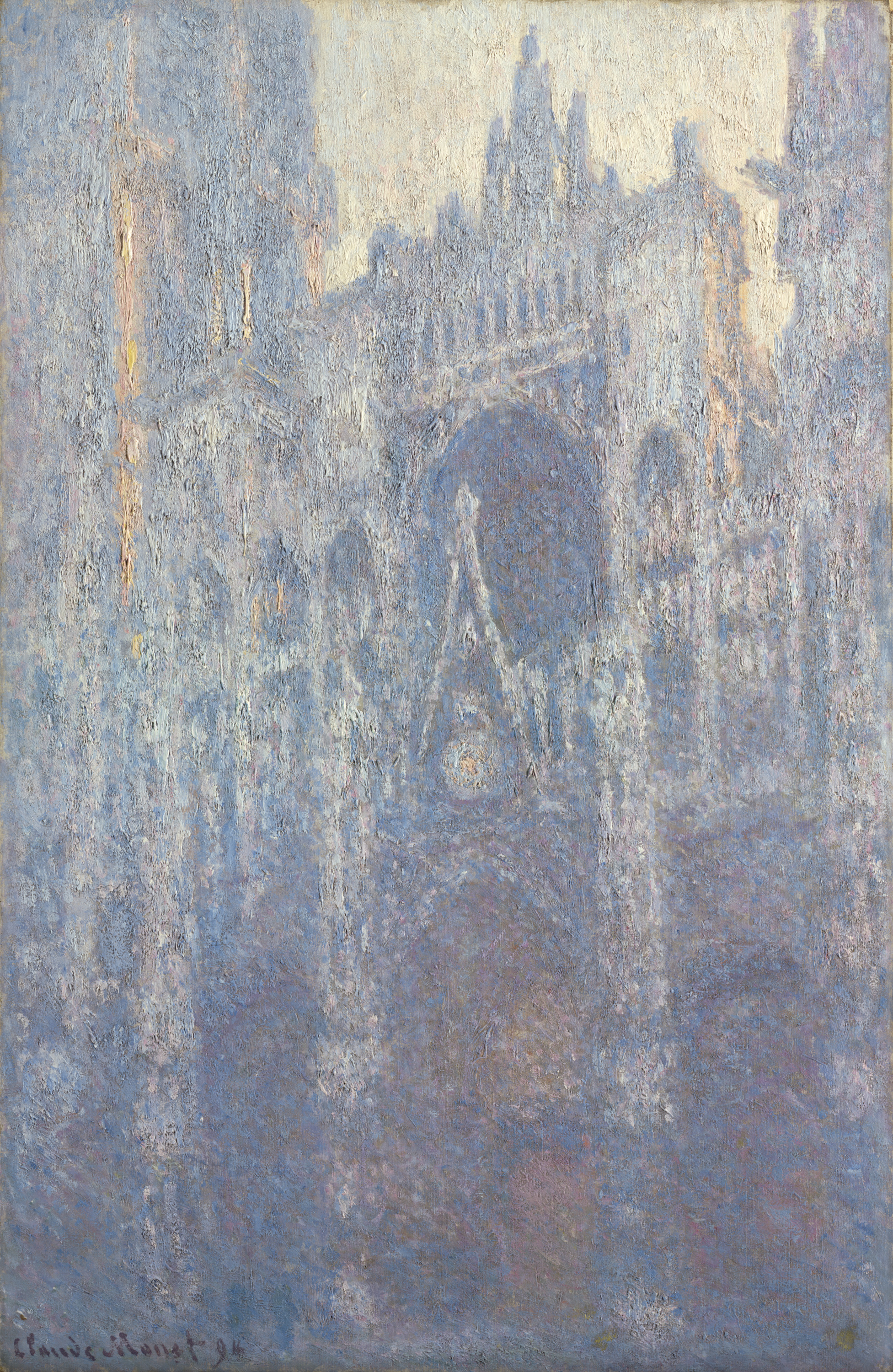In the 1890s, Monet depicted the west facade of Rouen Cathedral a total of twenty-eight times. The resulting series was his most ambitious and focused to date. Although the majority of the paintings, including the present work, were dated “94” by the artist, Monet actually began his campaign in 1892, working in Rouen between February and April of that year and then returning for the same time span in 1893, so as to ensure relatively constant seasonal weather and light conditions across the series. Monet subsequently retreated to his studio in Giverny and continued to work on the ensemble until he felt it ready for exhibition. This only happened, after much hesitation and several delays, in May 1895, when he showed a selection of twenty canvases, including the Getty painting, in the Paris galleries of his longstanding dealer, Durand-Ruel.1
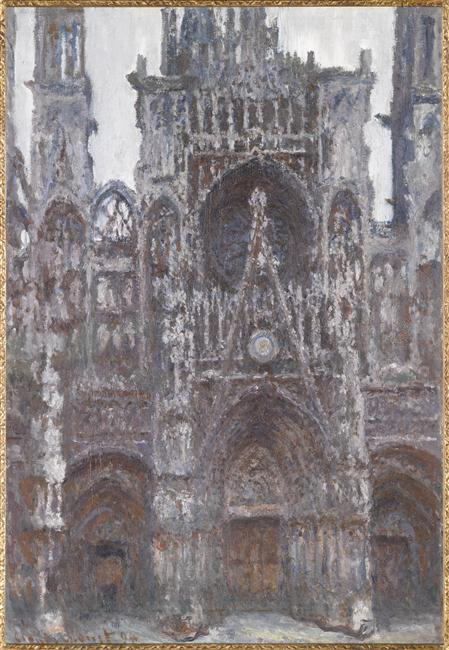
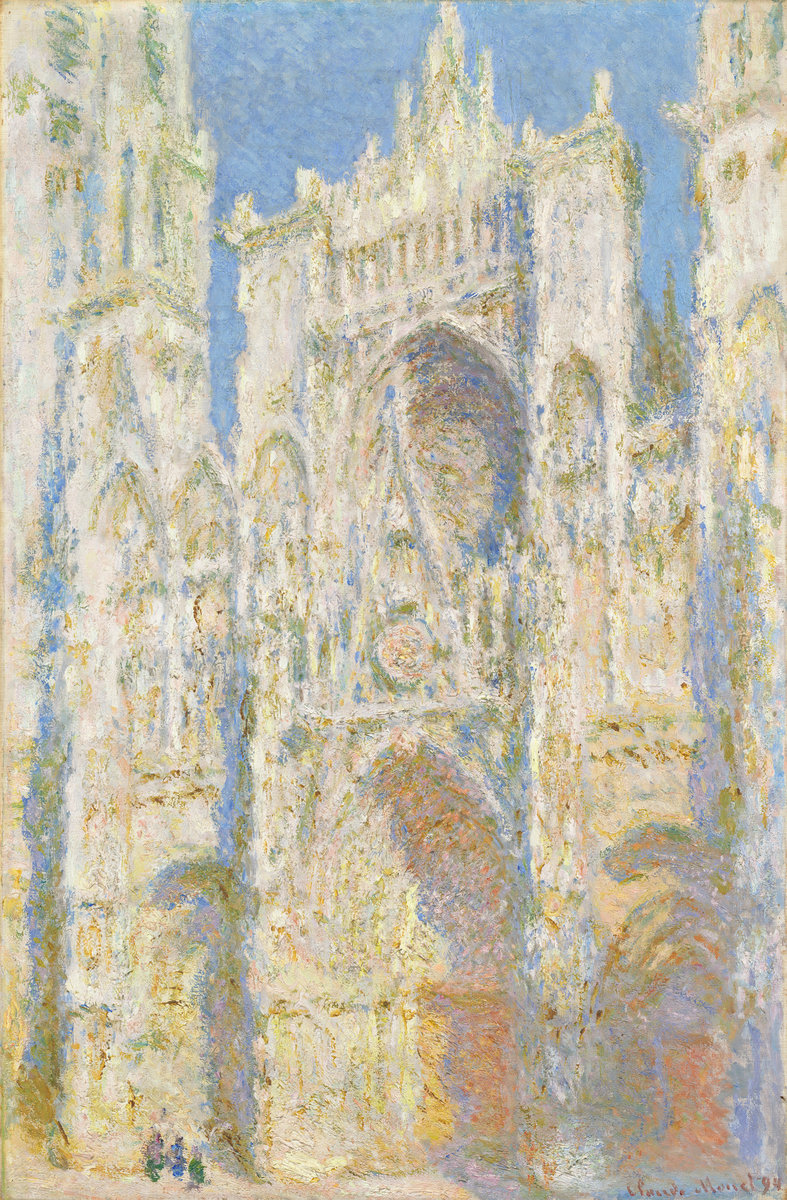
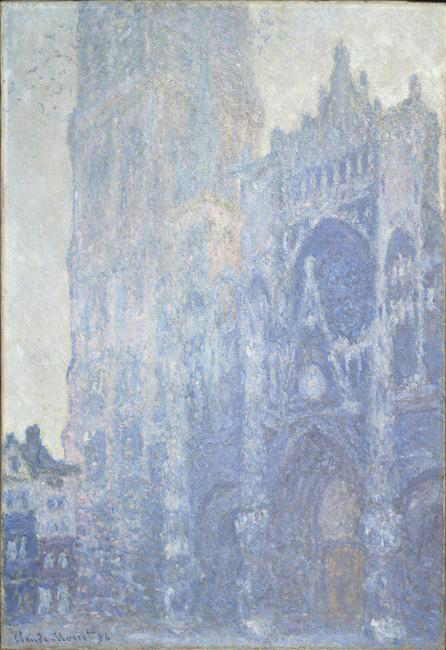
Monet tested various vantage points over the course of the series. He began by approaching the structure tentatively, from several angles, before concentrating on the main facade in February 1892.2 Over the course of his two extended sojourns, he would represent the cathedral from three different locations across the main square. He painted first, for a couple of weeks, from an apartment loaned to him by J. Louvet, a proprietor of a chemiserie shop, at 31, place de la Cathédrale. This apartment afforded him an almost direct frontal view (fig. 1). He then had the opportunity to set up an improvised studio a few doors down at 23, place de la Cathédrale, in the shop of Fernand Levy, who dealt in “lingerie et modes.” This address offered Monet a more oblique viewpoint, which corresponds to the majority of the paintings he began in 1892 (fig. 2). In 1893, after momentarily returning to Louvet’s apartment and then finding Levy’s shop unavailable (on account of the inconvenience the painter had apparently caused the shopkeeper and his customers the previous year),3 Monet procured an apartment above the novelty store of Édouard Mauquit, at 81, rue de Grand-Pont, near the southwestern corner of the cathedral square. Compared to Levy’s shop, Mauquit’s vantage point was farther off to the right, allowing the artist to take in more of the north tower of the facade—the tour Saint-Romain—and in several cases the adjacent houses (fig. 3). The Getty painting shares its southwesterly view with ten other canvases Monet began at Mauquit’s address in early 1893.4
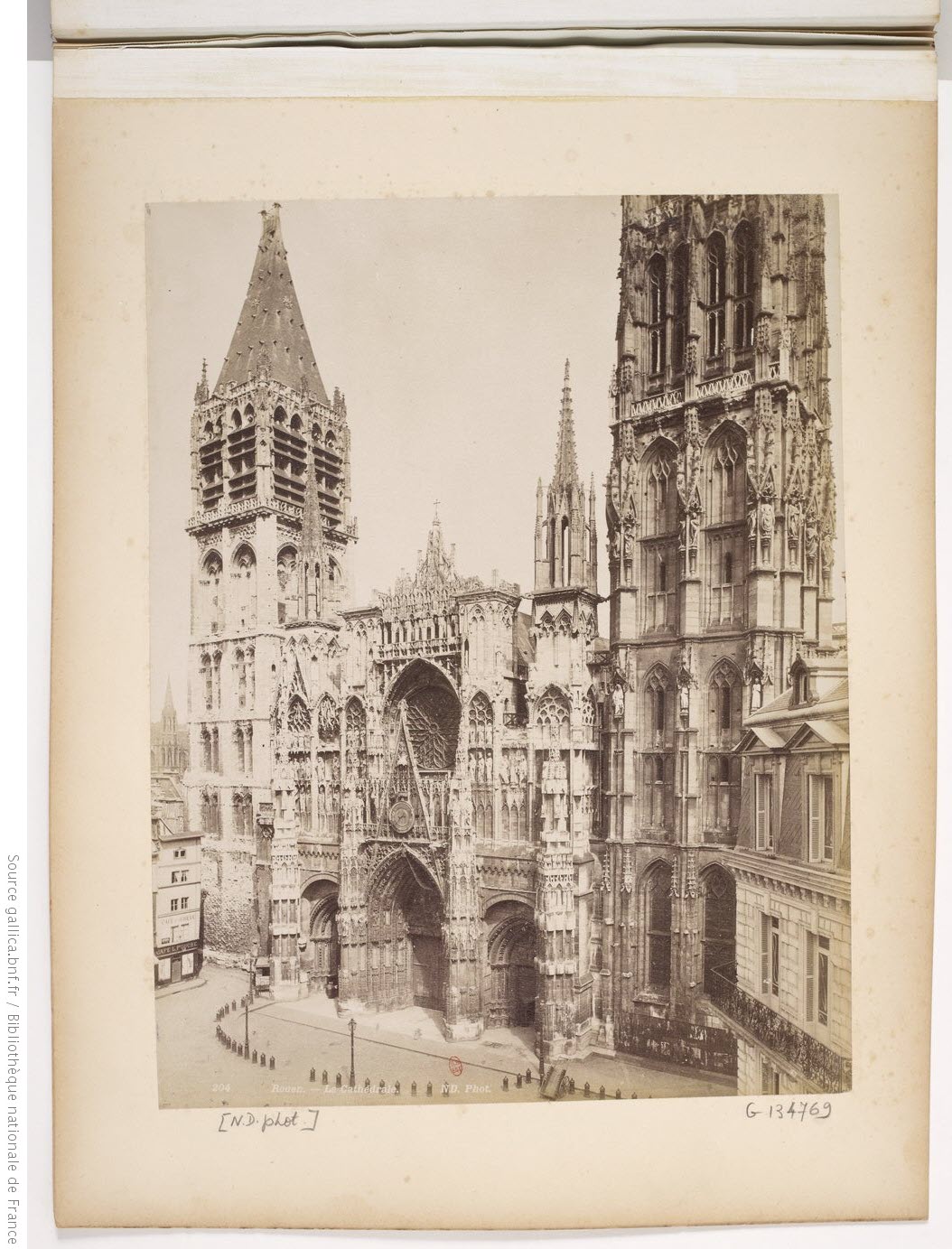
As in the other core works of the series, Monet has isolated and tightly cropped the facade in this painting, which is particularly evident if one compares the painting to contemporaneous photographs of the building (fig. 4).5 The Saint-Romain tower on the left side of the painting is truncated just above the level of the culminating pinnacle of the central portion of the facade, and only a sliver of the south tower is visible at right. Little indication is given of the sky apart from a pale, jagged wedge between the two towers. Below, the central portals rise immediately from the painting’s lower framing edge, so that any foreground plane that might offer the viewer an illusionistic point of entry into the picture is effectively eliminated, creating the claustrophobic sense of a lack of space. Some modicum of scale is provided by two evanescent figures hovering uncertainly in front of the cathedral, but their fugitive presence, less concrete than Monet’s own signature, seems almost an afterthought.
The painting’s dominant purplish-blue tonality suggests early morning. Vertical slivers of pale pink and yellow on the sides of the Saint-Romain tower and the short tower immediately adjacent to the central rose window indicate a raking light from the southeast. The lower portion of the facade, particularly the three main portals with their projecting aedicules, is still cast in shadow. Unlike his works of the 1870s, however, this painting does not create the fiction of an instantaneous impression of a particular time of day rapidly recorded. Its dense, complicated facture indicates that Monet worked much more slowly and accretively here, processing complex, dilated sensations over a much longer period. Encrusted layers of thick impasto vie with thinner flurries of scumbled brushwork to create a surface seemingly as weathered, ancient, and perduring as the cathedral facade itself, while simultaneously conjuring an atmosphere of pure light and color into which it all seems to be on the verge of dissolving.
Monet’s cathedral series marked his first attempt to concentrate on a fixed, architectural monument and broke abruptly from the natural and agricultural motifs of the grainstacks and poplars that the painter was painting in 1890 and 1891. Monet had depicted churches over the course of the previous decades, but they had always figured within the broader context of a surrounding city- or landscape. Never had he focused in such an exclusive way on a man-made structure, raising the question of his motivations for lighting upon Rouen Cathedral.
Biographical circumstance provides some context. Monet was already familiar with the cathedral, Rouen’s most notable monument, owing to his long-standing personal connections to the city.6 For much of his career, Rouen had featured prominently in his travels back and forth along the Seine valley between Paris and the Normandy coast.7 Monet’s brother, Leon, a chemist, lived on the outskirts, prompting frequent visits that resulted in paintings.8 Over the course of 1872–73, for instance, Monet painted at least fourteen views of Rouen and its immediate environs.9 Monet had also occasionally exhibited his paintings in the city and spent time there with fellow artists, such as Camille Pissarro (1831–1903).10 Rouen and its cathedral had thus been on his artistic horizons for some time. Later in his career, when he embarked on his series, it would have had the added appeal of proximity: it was only sixty kilometers from Giverny, where Monet had first settled in 1883. Health factors may also have conditioned his choice of the cathedral, for he could study it from a sheltered space like Mauquit’s apartment. Monet had suffered an attack of rheumatism in 1890 and sought to avoid undue exposure to the elements, particularly during the winter months.11
Marketing dynamics must also be considered. Before Monet dozens of French and English artists had painted the cathedral, a reflection in part of the church’s status as a famous tourist attraction, a centerpiece of the ancient capital of Normandy and a medieval coronation site.12 The iconic building was inevitably featured in travel guidebooks to the area, and some scholars have suggested that Monet availed himself of an engraved illustration from one such guidebook either as a source image or an aide-memoire.13 At a basic level, then, Monet’s paintings tapped into a ready-made iconography, guaranteeing a high level of recognition.
Monet would also have been aware of the historical, religious, social, and political associations with which cathedrals like that of Rouen were deeply charged in the late nineteenth century. He turned to the cathedral at a time when scholars were beginning to pay serious attention to the medieval artistic and architectural heritage of France. In the wake of France’s humiliating defeat in the Franco-Prussian War and in the face of its declining economic clout, the nationalist spirit of the ralliement adopted the Gothic cathedral as a supreme symbol of French cultural patrimony and former cultural hegemony. Meanwhile, various Catholic and mystical spiritual revivals found in the Church a nostalgic emblem of a society organized around faith, in contrast to the materialist and positivist spirit of the secular, scientific present. Finally, commentators of various stripes found a model of harmonious social integration in the cathedral and the collective efforts that went into its building.14 Monet’s cathedrals have consequently been seen to signal a conservative turn in his oeuvre, an abandonment of the sites of urban-industrial modernity that he embraced in the 1860s and 1870s—sites like the Gare Saint-Lazare, one of Paris’s new train stations, which had tellingly been described by Théophile Gautier as the “cathédrale de l’humanité nouvelle.”15 The Gothic cathedral, by contrast, was a symbol of permanent, unchanging tradition in the face of the spiritual, social, political, and economic upheavals of modernity.
Rouen Cathedral’s possible symbolic resonance for Monet should not, however, be overstated. By most accounts, he did not have serious antiquarian interests and he was evidently an agnostic, playing no part in the late-nineteenth-century religious revival. Indeed, in his paintings he minimized the cathedral’s Christian symbols, cutting off the cross that surmounted it. Similarly, by so isolating the facade, he demonstrated no concern for the social function or context of the building, in marked contrast, for instance, with Pissarro’s depictions (fig. 5).16
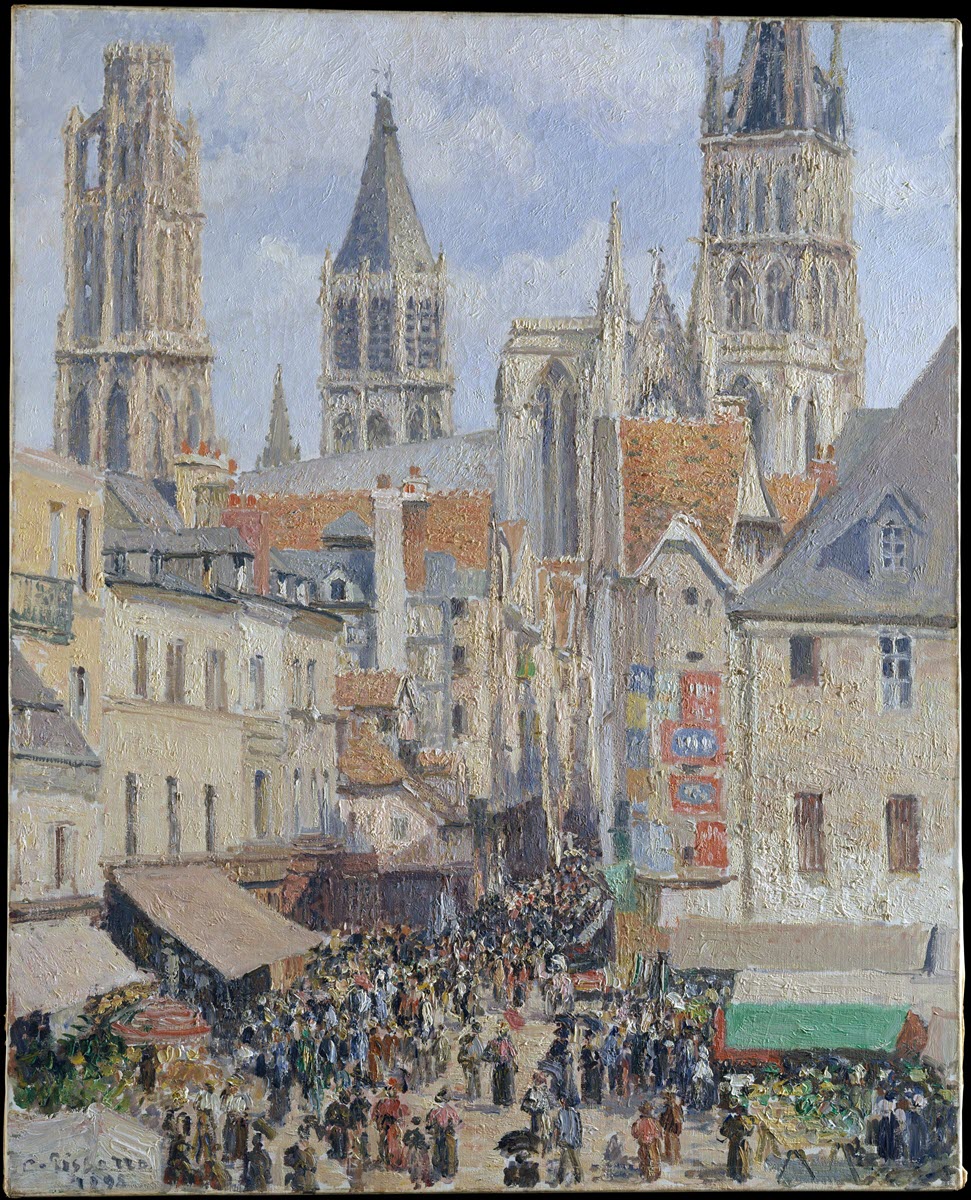
Monet’s primary motivations seem to have been aesthetic. The cathedral facade allowed him to systematize more rigorously his series practice by reducing contingent variables. It offered a ready-made composition—rich enough in its surface detail to sustain his attention—that allowed him to focus exclusively on variations of light and atmosphere and his cumulative, subjective sensations of them.17 At the same time, his choice of such a monumental motif testifies to an ambition to transmute Impressionist ephemerality into a more enduring aesthetic, one that would effectively respond to the mounting challenge of various Postimpressionist tendencies and assure the lasting posterity of his work. Given the ambitious size of the series, it was clearly intended to be a monument to Monet’s own perceptual consciousness and artistic vision, which he had been single-mindedly refining for decades. As he admitted in 1893, “I am a proud person with a devilish self-esteem. . . . I want these Cathedrals to be very good.”18
Judging by Monet’s correspondence, however, the elaboration of the series was fraught with difficulty as he shuttled between sometimes more than a dozen canvases per day while the light conditions changed.19 The inconsistent, uncooperative weather (“What terrible weather and what fluctuations!”)20 and the complex, unfamiliar motif (“Good God, this confounded cathedral is tough to do!”)21 were a constant source of anxiety. Monet frequently described his task as nearly impossible, and he was wracked with doubts about his ability to realize his sensations and judge his paintings adequately finished, hence his self-punishing compulsion to belabor and rework his canvases. “Alas, I can only repeat this,” he confessed in March 1893 to his friend, the critic Gustave Geffroy, “The further I go, the more difficulty I have rendering what I feel; and I tell myself that anyone who claims to have finished a picture is terribly conceited. Finishing means [making] complete, perfect, and I work so hard without advancing, searching, [and] proceeding hesitantly without achieving much.”22
It would take a substantial amount of studio work for Monet to bring the pictures to a satisfying conclusion. The artist worked concertedly to strengthen light effects, enrich shadows, key dominant hues with their complementaries, overlay scumbled veils of color, and reassert articulating strokes—all the while building up the overall painterly texture. Over the course of this studio work, aesthetic concerns came into play that ultimately distanced the series from its origins in the classic plein air methods of Impressionist naturalism. Most crucially, as Monet began looking forward to exhibiting the series, the overarching look of the ensemble became a prime consideration. Subgroups of pictures were consolidated in such a way as to make dominant tonalities as much a unifying factor as the particular times of day evoked. Indeed, as he pursued harmonious decorative and expressive color effects across the series, Monet introduced considerable ambiguity into the representation of specific weather effects. A case could be made that the Getty painting belongs just as categorically to a group of “blue” pictures as it does to any intended group of effets du matin.
Monet’s departure in the direction of a more unnaturalistic and expressive colorism was evident to a number of the series’ first reviewers in 1895. Uneasy about the mimetic truthfulness of the paintings, some critics objected to the seemingly arbitrary, exaggerated, and often iridescent colors, as well as to the dense, plasterlike paint handling. Others, however, were able to appreciate the series in terms of Monet’s attention to all the phases of daylight, and took it for granted that the artist’s hyper-refined and inherently subjective sensations of color, rather than any objective description of the cathedral, were the true subject of the works. Alternatively, critics attuned to the aestheticist and Symbolist concerns of the 1890s could readily appreciate Monet’s color in a more abstract, decorative, or “musical” sense.23
Whatever critics’ differences, it was generally agreed that the series was a triumph, and Monet’s exacting artistic vision was widely acclaimed, the patriotic resonances of the cathedral itself redounding to the paintings’ credit. Georges Clemenceau famously made an impassioned plea to President Félix Faure in La justice to secure the entire ensemble as a gift to the French Republic, arguing quite reasonably that the series could only be truly appreciated in its entirety.24
Of course this generous idea was never realized and the group was quickly dispersed. This fate was certainly intended by both Monet and Durand-Ruel, for there was a compelling marketing logic behind series painting. In the late-nineteenth-century art world, dominated by what Harrison White and Cynthia White famously dubbed “the dealer-critic system,” single-artist shows in dealers’ galleries were increasingly the norm.25 What those dealers marketed was not the big, singular statement—the type of picture dictated by the Salon system on account of its exhibition restrictions—but rather signature pieces of a larger oeuvre*:* a “Monet” in other words. Painting produced in series, furthermore, allowed the individual picture to accrue value through its association with an impressive larger whole. Ensure that there was enough pictorial variation throughout the series, and potential buyers would be afforded flattering leeway to exercise their own discerning judgment and taste.26
Monet set such store upon this particular series that he boldly demanded the high price of 15,000 francs per picture, more than three times what he asked for the Poplars in 1892 and five times what he had asked for his Grainstacks in 1891. This rapid inflation reflected the extraordinary amount of time and effort he had devoted to the set and was indicative of his self-confidence and optimistic sense of what the market would bear.27 Even as Monet delayed completion of the series over the course of 1894 and early 1895, he was busy generating advance interest in it and maneuvering to maintain control over sales, playing Durand-Ruel off other dealers and pressuring them to accede to his prices while simultaneously courting private collectors willing to pay them. Indeed, he succeeded in selling several canvases for 15,000 francs apiece months before the exhibition.28
Durand-Ruel, however, was astonished at the price Monet was asking, and in concert with several other interested dealers successfully pressured the painter to agree to compromise at a price of 12,000 francs. This wrangling over pricing ultimately soured the relationship between Monet and his dealer, particularly after, in the wake of the exhibition, Monet accused Durand-Ruel of actively undermining him. Although it was beyond the dealer’s professed means at the time to invest in a large lot of the Cathedrals himself, he did to his credit work to place several canvases with buyers on Monet’s behalf.29
The Getty painting was one of these. It was sold through Durand-Ruel to Louis Gonse, a prominent art critic, historian, and collector. His purchase was motivated partly by his personal taste for Impressionism; he owned one other work by Monet already,30 and the prestigious journal of which he was editor-in-chief, the Gazette des beaux-arts, had begun making accommodations for Impressionism and the “new painting” in the 1880s. Perhaps more importantly, one of Gonse’s abiding concerns as an art historian was French medieval art and architecture. Indeed, his landmark book, L’art gothique (1890), was one of the first comprehensive surveys of the subject. Gonse also exercised this scholarly commitment to Gothic art in his official capacity as a member, starting in 1891, of the Commission des monuments historiques. The appeal of Monet’s Cathedrals*,* radically modern in style yet traditional in subject, was thus an obvious one for Gonse, and one that was further strengthened by the collector’s close ties to Rouen, where his uncle’s family had been established for decades and where his father had served as a magistrate.31
- Scott C. Allan
-
Paris, Durand-Ruel, Tableaux de Claude Monet, May 10–31, 1895. The Portal of Rouen Cathedral in Morning Light was no. 13 and was exhibited under the title, “Le portail (Effet du matin).” For all the paintings included in the 1895 exhibition, see Daniel Wildenstein, Monet, or the Triumph of Impressionism, 4 vols. (Cologne: Wildenstein Institute, with Taschen, 1996), vol. 3, nos. 1317–19, 1321, 1322, 1324, 1325, 1345–47, 1349–55, 1357, 1359, 1360. For good detailed discussions of the entire Cathedral series, see Hélène Adhémar et al., Hommage à Claude Monet, exh. cat. (Paris: Grand Palais, with Réunion des musées nationaux, 1980), pp. 291–301; Grace Seiberling, Monet’s Series (New York: Garland, 1981), pp. 134–87 ; Paul Hayes Tucker, Monet in the '90s: The Series Paintings, exh. cat. (Boston: Museum of Fine Arts, with Yale University Press, 1989), pp. 143–87; Virginia Spate, Claude Monet: The Color of Time (London: Thames & Hudson, 1992), pp. 224–32; Gilles Grandjean, ed., Rouen, les cathédrales de Monet, exh. cat. (Rouen: Musée des beaux-arts with Réunion des musées nationaux, 1994); and Ronald R. Bernier, Monument, Moment, and Memory: Monet’s Cathedral in Fin de Siècle France (Lewisburg: Bucknell University Press, 2007). ↩︎
-
See Wildenstein 1996 (note 1), vol. 3, pp. 525–27, nos. 1314–18. ↩︎
-
See Grandjean 1994 (note 1), p. 25. ↩︎
-
See Wildenstein 1996 (note 1), vol. 3, pp. 552–64, nos. 1351–53, 1355–61. For the Getty painting, see pp. 555, 562, no. 1354. ↩︎
-
Eighteen paintings in the series, including the Getty painting, have the same dimensions (approximately 100 x 65 cm, which correspond to a standard M40 canvas) and present closely cropped views. See Seiberling 1981 (note 1), p. 154. ↩︎
-
On Monet’s connections to Rouen, see Jeanne-Marie David, “Monet in Rouen,” in A City for Impressionism: Monet, Pissarro, and Gauguin in Rouen, exh. cat., ed Laurent Salomé. (Rouen: Musée des Beaux-Arts, 2010), pp. 38–49. ↩︎
-
See George Heard Hamilton, Claude Monet’s Paintings of Rouen Cathedral (London: Oxford University Press, 1960), p. 16; and Spate 1992 (note 1), pp. 224–25. ↩︎
-
Tucker 1989 (note 1), p. 145. ↩︎
-
See Wildenstein 1996 (note 1), vol. 2, pp. 94–97, 115–16 , nos. 207–18, 267–68. ↩︎
-
Works by Monet were exhibited in Rouen in 1864, 1872, and 1884. See Wildenstein 1996 (note 1), vol. 2: p. 15, no. 20; pp. 77–78, no. 163; p. 129, no. 304; pp. 140–41, no. 338; p. 169, no. 415. ↩︎
-
Hamilton 1960 (note 7), pp. 16–17. ↩︎
-
Tucker 1989 (note 1), pp. 145–46. ↩︎
-
See, for instance, Spate 1992 (note 1), pp. 225–26. As Seiberling notes, however, it is unlikely that illustrations prompted Monet’s decision to paint the cathedral or prescribed his point of view. As noted, his approach to the cathedral was gradual and tentative, and his ultimate choice of viewpoints was contingent upon the location of the rooms across the square which he was able to procure. See Seiberling 1981 (note 1), pp. 140–41. ↩︎
-
On these various associations, see Tucker 1989 (note 1), p. 143. ↩︎
-
Quoted in Sylvie Patin, “Une cathédrale ‘bleue ou rose ou jaune,’” in Grandjean 1994 (note 1), p. 37. ↩︎
-
As variously noted by Hamilton 1960 (note 7), pp. 24–26; Seiberling 1981 (note 1), pp. 136–37; Bernier 2007 (note 1), p. 38; and others. ↩︎
-
See Spate 1992 (note 1), p. 225; Hamilton 1960 (note 7), p. 17; Seiberling 1981 (note 1), p. 137. ↩︎
-
" J’ai un orgueil et un amour-propre du diable, je veux faire mieux et voudrais que ces Cathédrales soient très bien. . . ." (letter to Alice Monet, April 7, 1893, reprinted in Daniel Wildenstein, Claude Monet: Biographie et catalogue raisonné, 5 vols. [Lausanne & Paris: La Bibliothèque des Arts, 1974–91], vol. 3 [1979], p. 273, letter 1209). ↩︎
-
Spate 1992 (note 1), pp. 227–29. ↩︎
-
“Quel terrible temps et que de changements!” (letter to Alice Monet, Feb. 22, 1893, reprinted in Wildenstein 1974–91 [note 18], vol. 3, p. 270, letter 1179). ↩︎
-
" Bon Dieu, que cette mâtine de cathédrale est . . . dure à faire !" (ibid). ↩︎
-
“Helas! Je ne puis que répéter ceci: que plus je vais, plus j’ai de mal à rendre ce que je sens; et je me dis que celui qui dit avoir fini une toile est un terrible orgueilleux. Finir voulant dire complet, parfait, et je travaille à force sans avancer, cherchant, tâtonnant, sans aboutir à grand-chose, mais au point d’en être fatigué” (letter to Gustave Geffroy, March 28, 1893, reprinted in Wildenstein 1974–91 [note 18], vol. 3, p. 272, letter 1201). ↩︎
-
I can only hint at the range and complexity of responses to the series here. For fuller discussions, see, for example, Seiberling 1981 (note 1), pp. 170–82; Tucker 1989 (note 1), pp. 180–87; Spate 1992 (note 1), pp. 230–32; and François Bergot, “1895, Révélation des Cathédrales: l’avant-garde et l’intemporel,” in Grandjean 1994 (note 1), pp. 15–21. ↩︎
-
Clemenceau, “Révolution de Cathédrales,” La justice (May 20, 1895), reprinted in Grandjean 1994 (note 1), pp. 99–103. ↩︎
-
See Harrison C. White and Cynthia A. White, Canvases and Careers: Institutional Change in the French Painting World (New York: Wiley, 1965). ↩︎
-
On the commercial motives behind Monet’s series paintings, see John Klein, “The Dispersal of the Modernist Series,” Oxford Art Journal 21: 1 (1998), pp. 121–35. ↩︎
-
See Tucker 1989 (note 1), p. 165; and Bernier 2007 (note 1), pp. 45–46. ↩︎
-
These were the paintings bought by Isaac de Camondo, and now in the Musée d’Orsay. See Wildenstein 1996 (note 1), vol. 3, nos. 1321, 1346, 1355, 1360. ↩︎
-
Regarding the pricing of Monet’s series and the artist’s increasingly tense relationship with his dealer in the months leading up to and following the May 1895 exhibition, see in particular Bernier 2007 (note 1), pp. 44–47. ↩︎
-
This was The Bay of Antibes (1888), which Gonse bought on the occasion of the Monet-Rodin exhibition at the Galerie Georges Petit in Paris in 1889. See Wildenstein 1996 (note 1), vol. 3, p. 442, no. 1161. ↩︎
-
On Louis Gonse, see André Michel, “Louis Gonse,” Gazette des beaux-arts, 5th ser., 5 (February 1922), pp. 85–88; François Gonse, “Louis Gonse (1846–1921) et le Japon,” Gazette des beaux-arts, 6 ser., 119, no. 1477 (February 1992), pp. 81–88; and François Gonse, “Louis Gonse (1846–1921): Historien, critique, et amateur d’art,” (Thèse de la maîtrise, Université de Paris IV-Sorbonne, 1990), especially pp. 25–27, 105–7, 119n61. I am grateful to François Gonse, whose great-great-grandfather was Louis Gonse’s uncle, for generously supplying me with copies of relevant sections of his maîtrise and for additional biographical information. ↩︎
